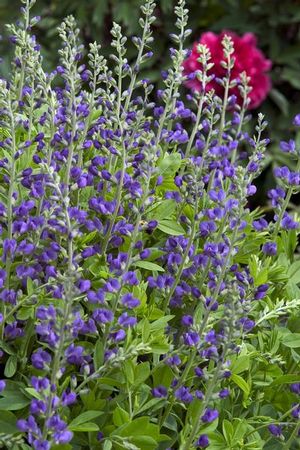Printed at http://www.newmoonnursery.com/index.cfm/

Drought tolerant, blue false indigo is suitable for restoration and conservation, meadow areas, and use as a landscape ornamental.
Baptisia australis
Blue false indigo
Native to North America
FIRST IMPRESSIONS: Baptisia australis is a dense shrubby perennial with attractive blue-green leaves. In late spring, blue to indigo pea-shaped flowers are held aloft on upright flower stalks. A patch of Baptisia australis in full bloom is a sight to behold - reminiscent of exotic lupines or Texas bluebonnets on steroids. A plant of such beauty should be a prima donna but this species thrives in harsh conditions and once established is durable and long lived.
HABITAT & HARDINESS: The range of Baptisia australis reaches into Canada and extends through most of the central and eastern United States.
This species is indigenous in prairies and pastures, along tree lines, in rocky open woodlands, and along rocky creek banks.
Plants are hardy from USDA Zones 4-8.
PLANT DESCRIPTION: Baptisia australis is densely branched with a mounding form and glaucous trifoliate leaves.
Plants are anchored by a sturdy branched taproot. Dramatic asparagus-like buds emerge from the roots in spring already topped with immature flower buds.
As plants attain their mature height, the flower buds unfurl into a striking display of deep indigo pea-like blooms. The flowers are arranged in erect racemes and are frequented by bees and butterflies.
The flowers evolve into inflated deep purple pods that are unique and attractive landscape features.
Plants grow 3-4’ tall with 3-4’ spread.
CULTURAL & MAINTENANCE NEEDS: Baptisia australis grows best in full sun or light shade in well drained average to moist soil.
Young plants expend a good bit of energy producing deep roots. As a result they tend to get off to a slow start. Around the third year when roots are established, the upper half of the plant begins to flourish.
Plants tolerate drought and controlled burns. They are pest resistant and somewhat unpalatable to deer, rabbits and livestock.
After establishment, excess shade and competition from neighboring plants are the only things that can inhibit the growth of this tough guy.
LANDSCAPE USES: This is a good choice for a Wildlife Garden, Prairie or Dry Meadow. Plants are also used as Butterfly Nectar Plants, Butterfly Host Plants or as part of a Grouping or Mass Planting. Baptisia australis has Showy Blooms, attractive fruit and can be used in Cottage Gardens, Deer Resistant Plantings, Low Maintenance Plantings and Perennial Borders
COMPANION & UNDERSTUDY PLANTS: Try pairing with Asclepias tuberosa, Echinacea purpurea, Eryngium yuccifolium, Rudbeckia hirta, Solidago speciosa, and Sorghastrum nutans.
Baptisia tinctoria has similar flowers and foliage and can be substituted if needed.
TRIVIA: Baptisia australis was named the 2010 Perennial Plant of the Year by the Perennial Plant Association and one of the top 200 plants of the last 200 years by the Royal Horticultural Society.
Plants host caterpillars of Frosted Elfin, Eastern Tailed Blue, Wild Indigo Duskywing, Clouded Sulfur and Orange Sulfur Butterflies as well as the caterpillars of moths and skippers.
Cherokee Indians and early settlers prepared a blue dye from Baptisia australis roots. When the exotic but superior true indigo plant became available, it was used instead. The common name false blue indigo, however, remained attached to Baptisia australis.
Plant sap turns an inky blue color when exposed to the air.
Height:
3-4 ftSpread:
3-4 ftSpacing:
6-8 ftUSDA Hardiness Zone:
4-8Bloom Color:
Purple RedBaptisia australis Characteristics
Attracts Wildlife
- Pollinators
- Butterflies
Attributes
- East-Coast Native
- Drought Tolerant
- Clay Soil
- Bog
- Naturalizing
- Rain Garden
- Interesting Foliage
- Favorite
Exposure
- Full Sun
Deer Resistant
- Deer Resistant
Flowering Months
- June
- May
Foliage Color
- Green
Salt Tolerance
- Medium
Soil Moisture Preference
- Moist to Dry
Interesting Notes:
For more information on this plant, visit the USDA PLANTS Database: http://plants.usda.gov/java/profile?symbol=BAAU
